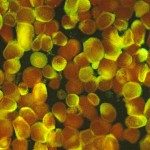Lien vers Pubmed [PMID] – 25172991
Lien DOI – 10.1016/j.jsb.2014.08.002
J Struct Biol 2014 Oct; 188(1): 71-8
Nuclear magnetic resonance spectroscopy is a powerful tool to study structural and functional properties of proteins, provided that they can be enriched in stable isotopes such as (15)N, (13)C and (2)H. This is usually easy and inexpensive when the proteins are expressed in Escherichiacoli, but many eukaryotic (human in particular) proteins cannot be produced this way. An alternative is to express them in insect cells. Labeled insect cell growth media are commercially available but at prohibitive prices, limiting the NMR studies to only a subset of biologically important proteins. Non-commercial solutions from academic institutions have been proposed, but none of them is really satisfying. We have developed a (15)N-labeling procedure based on the use of a commercial medium depleted of all amino acids and supplemented with a (15)N-labeled yeast autolysate for a total cost about five times lower than that of the currently available solutions. We have applied our procedure to the production of a non-polymerizable mutant of actin in Sf9 cells and of fragments of eukaryotic and viral membrane fusion proteins in S2 cells, which typically cannot be produced in E. coli, with production yields comparable to those obtained with standard commercial media. Our results support, in particular, the putative limits of a self-folding domain within a viral glycoprotein of unknown structure.









